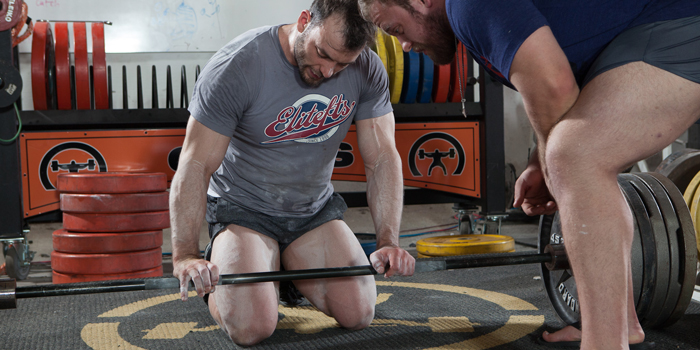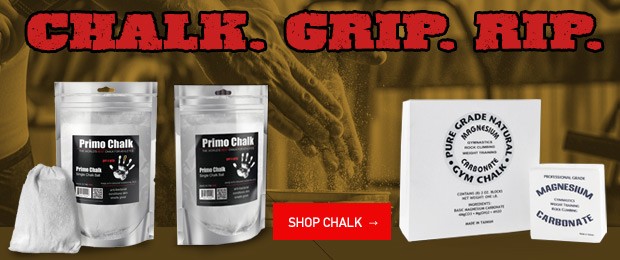
“Make it so tight that even if I chop [your] hand off, the hand will stay on the bar.” — Tommy Kono
I’ve been using a hook grip on my deadlifts for a couple of years now, after suffering a bicep tear and finding that it’s very difficult for me to get in the right position for sumo deadlifts using a mixed grip. It’s worked very well for me, although I still struggle holding on to the bar when the weights start to creep up and over the 95% range. As a result, I spend a lot of time studying, strengthening, and trying to perfect my hook grip.
RECENT: What I Learned from Benching with Dave Tate
There is an astronomical amount of misinformation floating around right now about the hook grip, and, in my opinion, that’s the result of a lot of people (mostly beginners) using the hook grip inappropriately. In reality:
- Chances are, you are better off not using a hook grip.
- The hook grip often works better for people with smaller hands.
- The hook grip isn’t painful.
Now, keep in mind my go-to motto: everyone is different. Yeah, you might be the exception to the rule — but if you are, you probably know it already.
How to Perform the Hook Grip
Let’s start off with the basics. This video is a pretty good introduction to performing the hook grip.
Too long, didn’t watch? Here’s a recap:
- Start by straightening your arms and fingers as if you were trying to draw a straight line from your shoulder to the tip of your thumb. Point your thumb directly at the ground; stretch your fingers wide.
- Approach the bar and dig the crease of your hand formed by the gap between your thumb and index finger into the bar as far as you can. (If your skin is tearing when you pull with a hook, you’re probably not digging in hard enough here.)
- Wrap your thumb around the bar so that it lies directly between the bar and the floor.
- Wrap your fingers around the thumb and the bar, beginning with the little finger and ending with the index finger.
- I like to give a little tug on the bar before I start to lift, just to make sure everything’s in the right place.
That’s all there is to it — it’s not a complicated technique, and, if you’re well-suited for hooking, it should feel entirely natural. I pulled a lifetime PR 635x3 the first time I tried the hook grip. If you’re struggling to find the right positioning, it’s overwhelmingly likely that you’re better off pulling with a mixed grip.
The Pros and Cons of the Hook Grip
Don’t get it twisted: There are definitely some advantages to pulling with a hook grip. The biggest one is safety. Any double-overhand grip, including hook, takes pressure off of the biceps tendon and makes the risk of a tear much more unlikely. I started pulling with a hook grip because I tore my biceps tendon at the elbow on a 1,000-pound tire flip, and even after recovering my strength, I lacked the nerve to risk any sort of similar injury ever again.
In truth, though, the risk of tearing a bicep even with a mixed grip is pretty damn low — as long as you use good form and don’t yank the bar off the ground. The guys who pop their bi's are usually pulling over 700 pounds, or they’re letting their arms take some of the load off the floor. When you pull, let your arms hang slack, like ropes, and you won’t have to worry about that particular injury.
A hook grip also allows for a more symmetrical pull, which is very important if you’re concerned about your physique. I used a mixed grip to deadlift for a decade before I tore my bicep, and, as a result, my right lat and trap is overdeveloped when compared to my left. If physique is your primary concern, or if you don’t plan on competing in powerlifting, you can obviously pull with straps to mitigate the issue of symmetry. If you use a mixed grip, I suggest alternating your over-and-under-grip hands during your warm-up sets to get more balanced development.
WATCH: Deadlift Tips on Tightness, Speed Pulls, and Hook Grip
Finally, it’s possible that the hook is more secure than the mixed grip, for you. That last part is key: it’s all going to come down to your individual strengths, weaknesses, and leverages. There’s no one right answer here.
Unfortunately, hook grip comes with a lot of drawbacks. First, it takes a bit longer to set up. Getting your thumb positioned correctly doesn’t take long, but it does take long enough to make a grip n' rip deadlift pretty much impossible.
Side Rant: No one should ever grip and rip in the first place unless they’re looking for a shitty pull or a torn bicep. The deadlift is just as technical as the squat and bench, and it takes a few moments to position yourself correctly. Some really proficient deadlifters might make setup so quickly it’s almost imperceptible, but chances are if you see someone just grab the bar and pull, they’re not a good deadlifter. Even if they can move a lot of weight, they almost certainly struggle with lockout and could move even more weight with better technique.
Back to the hook grip: Besides taking longer to set up, it’s also much more difficult to strengthen than a mixed grip. Fortunately, “difficult” doesn’t mean impossible. Here are a few places to start if you’re looking to improve your hook:
- Thumb mobility. Just like your glutes and quads can get tight, so can the muscles of your hands. Massage, stretching, and other bodywork modalities can loosen up your thumbs and fingers, making it easier to get your hand in position for a more secure grip. Make sure to look all the way up the arm for other tightnesses: a lack of pronation caused by lack of mobility at the elbow or shoulder can also make a strong hook grip hard to find.
- Finger strength. Most grip exercises don’t carry over to the hook, but a few do. Look for movements that strengthen the thumbs and fingers individually and in both extension and flexion. Fat bar timed holds are a good choice, as are the exercises in the video below.
- Friction. Dry skin is absolutely crucial for a secure hook grip. If you’ve got sweaty palms, consider using both liquid chalk and regular gym chalk during your workouts (the combination tends to work better than either alone). You can also use antiperspirant on your hands the night before a heavy deadlift session — or, if the problem is very bad, get some prescription medication from a doctor.
Debunking the Hook Grip Myths
The hook grip is more secure than mixed grip.
I’ve hinted at this one above. I think a lot of 400-600 pound pullers are starting to switch to a hook grip because they believe it’s more secure than a mixed grip. In reality, hook grip can still fail, just as dramatically as a mixed grip can. I’ve experienced that frustration myself more times than I care to remember!
It’s fairly easy to argue that the hook grip isn’t inherently better: If it were, you’d see the majority of people using it to deadlift. It’s not like the hook grip is some big secret. In fact, it’s actually older than the whole sport of powerlifting! And yet, the vast majority of lifters over the past fifty years have used a mixed grip to deadlift, at all levels of proficiency.
-
I have small hands, so I can’t use the hook grip.
Total bullshit. You can be very successful with the hook grip even with small hands. Small hands are going to make any sort of gripping more difficult; it sucks, but it’s reality. Fortunately, there’s a good chance that if your grip strength is limited by the size of your hands, you’ll get more out of the hook grip.
Want proof? Take a look at John Davis, who, especially during the prime of his career, many consider to be the best weightlifter of all time. Davis stood 5 feet, 8 inches tall, and weighed just under 220 pounds, so he was pretty damn thick. According to strength historian Terry Todd, though, Davis’s hands were “freakishly small” — so small he had a difficult time securing a hook grip on a standard barbell. That didn’t stop Davis from winning two Olympic gold medals, six World Championships, and setting 16 world records, including the first clean and jerk over 400 pounds in history. If you use a deadlift bar, it’s even thinner than the barbells Davis would have used, so you really have no excuse.
Just to be clear: I’m not saying that a person with small hands is going to have a stronger hook grip than a person with large hands. The person with large hands is almost always going to have a stronger grip, regardless of whether it’s hook or not. But if you’re a small-handed person, you’re more likely to benefit from a hook grip relative to a mixed grip than is a larger-handed person.
-
Hook grip is very painful.
If the small amount of pain caused by using a hook grip is enough to bother you, you might be in the wrong sport.
Should You Use Hook?
Look, here’s the bottom line for any question like this: everyone is different. I can’t tell you whether hook is right for you, and neither can anyone but yourself. There are simply too many individual variances to make a one-size-fits-all prescription — any anyone who tells you otherwise is probably trying to rip you off in one way or another.
So, should you use hook grip? I don’t know. Give it a try and see if it works for you! But if it doesn’t seem to be working pretty much immediately, know that it’s probably not worth your time to grind away at. Use that physical and mental energy to get stronger all over instead, and you’ll be better off.










